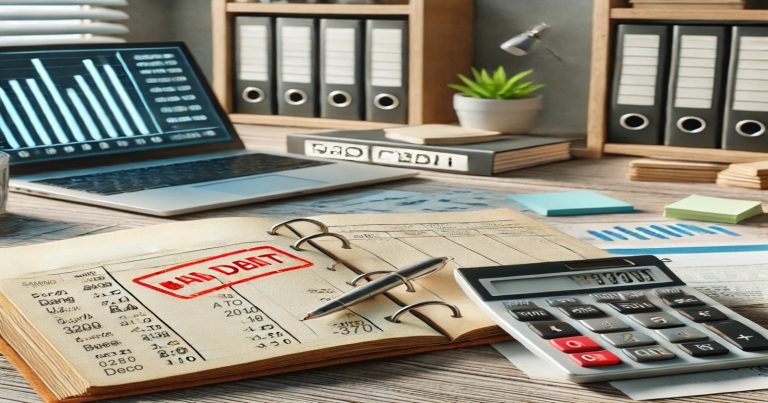Businesses sell goods or services on credit. But not every customer pays that back. When a customer is unable to pay the amount despite several reminders, it is considered a bad debt. This loss is recorded in the books of accounts as a bad debts journal entry. In accounting, businesses are required to maintain accurate records. A key component of this is writing off bad debts. It assists businesses in demonstrating a true picture of financial health. Journal entry for bad debts will help you identify non-recoverable amount. It also ensures a proper matching of income and expenses. Doing so increases transparency of financial statements. Handling bad debts in accounting is a skill required for every business, no matter the size.
What is a Bad Debt Journal Entry?
When businesses sell products and services on credit, anticipating the customers will pay at a later date. But, at times, customers don’t pay. Such unpaid amounts are known as bad debts. This acts as a journal entry of bad debts which forms the book of accounts. Two useful transactions mentioned above are when an amount cannot be collected and it is written off as bad. This is also referred to as writing off a debt.
Types of Bad Debt Entries
There are several ways to record bad debt:
- Journal entry for bad debt expense: When the business writes off the debt as bad.
- Journal Entries for Bad debts written off: When the amount is ceasing to exist on the books.
- Bad debts recovered journal entry: Used when the company received cash against writing off the debt.
- Provision for bad debts journal entry: When the business anticipates that a portion of its debt may be unrecoverable in the future.
Each of these entries has its own reason and its own time to be when to be used.
Basic Format for Bad Debts Journal Entry
The entry for the write-off of a bad debt is:
Bad Debts A/c Dr
To Sundry Debtors A/c
This reduces the balance of the debtor and results in a loss in the profit and loss account.
Where is Bad Debt Entry Made?
That is, in accounting all transaction must show up in the proper account. In case of bad/debt bad debt it hits both the balance sheet and profit & loss account.
Journal Entry in Profit and Loss Account
For example, the journal entry for bad debts affects the profit and loss account. The fee decreases the company’s net profit. Bad debt is shown as an “Indirect Expense.”
Recording in Balance Sheet
In the balance sheet:
- The sundry debtors reduce.
- If provision exists, then bad debt is adjusted from that reserve.
- Subsequent recovery of any bad debts is credited on the income side.
Journal Entry for Bad Debts in Tally
In Tally, go to:
- Path: Gateway of Tally > Accounting Vouchers > F7 : Journal
- For that, Debit “Bad Debts” and credit the specific “Sundry Debtor” account.
- Add narration for clarity.
Bad debts journal entry in Tally helps you keep the records easy with auto-updated ledgers. Hence, bad debts entries become highly significant whether it is a manual accounting book or a software accounting system.
What are Cause of Bad Debt?
What is the reason behind the bad debt? Knowing them can help avoid losses in the future.
Top Reasons for Bad Debts
- Customer’s Financial Failure: Customer declares insolvency or runs out of cash.
- Fraud: Some customers don’t plan to pay at all.
- Bad Credit Checks: Business does not check the creditworthiness of the customer.
- Inadequate follow–ups: Not following up in time results in payment to fail.
- Disputes or Quality Issues: A customer may not want to pay if the product was damaged.
- Data pending and incomplete: Businesses place excessive trust in customers they have long worked with.
Effect on Business
An income of the business is reduced as bad debts. They impact profit, deplete liquidity and indicate bad collection of accounts receivable.
Understanding these causes enables you to enhance internal control and refine credit policies.
Importance of Bad Debt Expense
All business needs to display authentic profit. That means all income and expenses need to be properly accounted for. This journal entry for bad debt expense makes sure this is reported correctly.
- True Financial Health — It indicates the real recoverable revenue.
- Expense Matching: It matches the income to the expenses that are associated with it, but only during the same time period.
- Control Tool: It is used for tracking non-paying customers.
- Assistance in Tax Deductions: In some instances, businesses can benefit from tax deduction on bad debts.
A proper entry to the books to truly reflect the financial health of the books and aid in the future planning.
Method of Recording Bad Debt Expense
Bad debts are usually written off in one of two ways.
Direct Write-off Method
With this method, you report the bad debt when you know that amount is not collectible.
Journal Entry:
Bad Debts A/c Dr
To Debtors A/c
This is a simple approach but it does not adhere to the matching principle.
Allowance Method
This approach involves setting aside an amount every year based on anticipated bad debts. This is more accurate.
Journal Entry:
Bad Debt Expense A/c Dr
To Bad debts A/c Provision
If an individual debtor is then named:
To Provision for Bad Debts A/c Dr
To Debtors A/c
Suitable for large businesses.
Journal Entry for Provision for Bad Debts
Businesses keep a reserve or allowance for bad debts. This reserve is established by the following entry:
Bad Debt Expense A/c Dr
To Bad Debt Reserve A/c
This on-boarding helps to mitigate risk and enhances planning.
Example of Bad Debt Journal Entry
Now let us understand the journal entries with the help of an elaborate example.
Example 1: Debtors Written off as Bad Debts
ABC Ltd. sold goods on credit, for ₹10,000, to Mr. Raj. Its been 6 months and Mr. Raj hasn’t paid either. ABC Ltd. wrote it off.
Journal Entry:
Bad Debts A/c Dr ₹10,000
To Mr. Raj A/c ₹10,000
This report lists the amount as a loss.
Example 2: Bad debts allowance
Debtors — ABC Ltd. believes 5% of ₹2,00,000 debtors are likely to default.
Journal Entry:
Bad Debt Expense A/c Dr ₹10,000
To Provision for Bad Debts A/c ₹10,000
This establishes a reserve for potential losses.
Example 3: Bad Debts Recovered
ABC Ltd. wrote off ₹5,000 last year from Mr. Amit. This year, he paid back.
Journal Entry:
Cash A/c Dr ₹5,000
To Bad Debts Recovered A/c ₹5,000
Bank Reconciliation of ₹25,000 as a Difference (Debits) to Bad Debts Recovered A/c ₹5,000
This raises income in the current year.
Relevance to ACCA Syllabus
The journal entry of bad debts is well-thought-out in Financial Accounting (FA) and Financial Reporting (FR) papers. Recording, writing off and recovering bad debts are part of maintaining fair and accurate financial statements and all ACCA students need to understand this process.
Bad Debts Journal Entry ACCA Questions
Q1. When a bad debt is written off, which account is debited?
A. Sales Account
B. Debtor’s Account
C. Bad Debts Account
D. Cash Account
Answer: C. Bad Debts Account
Q2. Answer: Journal Entry of Provision for Bad Debts
Q. What is the Journal Entry of Bad Debts?
B. Bad Debts A/c Dr. To Provision A/c
C. Book of Accounts Bad Debts Expense A/c Dr To Bad Debts Provision A/c
D. Cash A/c Dr To Provision for Bad Debts A/c
Answer: Dr. Bad Debts Expense A/c To Provision for Bad Debts A/c
Q3. Which of the following statements is true with respect to bad debts recovered?
A. It is considered negative, like a liability
B. It increases expenses
C. It is treated as an income
D. It affects cash outflow
Answer: C. It is treated as an income
Q4. What happens on the balance sheet when you have bad debt?
A. It increases liabilities
B. It increases equity
C. It decreases accounts receivable
D. It has no effect
Answer: C. It decreases accounts receivable
Q5. A company follows the allowance method, which entry is made in writing off a particular bad debt?
A. Debtor A/c Dr To Cash A/c
B. Bad Debts A/c Dr To Debtor A/c
C. Bad Debts Expense A/c Dr To Accounts Receivable A/c
D. Debtor A/c Dr Bad Debts Recovered A/c Cr
Answer: C. Provision for Bad debts A/c Dr To Debtor A/c
Relevance to US CMA Syllabus
In Financial Reporting, Planning, Performance and Control US CMA, our students learn about the recognition and measurement of expenses like bad debts. It examines financial accuracy and ethical reporting.
Bad Debts Journal Entry US CMA Questions
Q1. When a bad debt is recorded using the direct write-off method, which is the correct entry?
A. Sales A/c Dr To Debtor A/c
B. Dr. PV To Bad Debt A/cDr.
C. Debtor A/c Dr To Bad Debts A/c
D. Cash A/c Dr To Sales A/c
Answer: b. Bad Debts A/c Dr To Debtor A/c
Q2. What does the allowance method provide for when accounting for bad debt?
A. Expenditure is recognized when it is paid
B. Matching expense to related revenue
C. No effect on financial statements
D. Increase in receivables
Answer: B. Matching of expenses with associated revenue
Q3. Where does bad debt expense appear on financial statements?
A. Balance Sheet under Assets
B. Income through Profit and Loss
C. Expense in the Form of Profit and Loss
D. Statement of Cash Flows
Answer: C. Profit and Loss as an Expense
Q4. What is the effect of creating a bad debt provision?
A. Increases liabilities
B. Reduces revenue
C. Increases net profit
D. Reduces net receivables
Answer: D. Decreases net receivables
Q5. Which one of them is not a cause of bad debts?
A. Customer insolvency
B. Goods returned
C. Fraudulent buyer
D. Dispute over payment
Answer: B. Goods returned
Relevance to US CPA Syllabus
Some of it is covered in the FAR (Financial Accounting and Reporting) section of the US CPA in relation to accounts receivable and bad debt treatment. Candidates must understand how accounting principles apply in order to make accurate financial disclosures.
Bad Debts Journal Entry CPA Questions
Q1. What concept advocates the use of the allowance method for bad debts?
A. Consistency
B. Conservatism
C. Matching Principle
D. Going Concern
Answer: C. Matching Principle
Q2. Do bad debts affect net income and how?
A. It increases net income
B. It reduces net income
C does not impact net income
D. It increases equity
Answer: B. It makes a negative impact on net income
Q3. What method do you prefer for recording bad debts under GAAP?
A. Direct Write-off Method
B. Revenue Recognition Method
C. Allowance Method
D. Cash Basis
Answer: C. Allowance Method
Q4. What if a previously written-off debt is recovered?
A. Liability is created
B. Income is recorded
C. Expense is recorded
D. Asset is reduced
Answer: B. Income is recorded
Q5. Which account does the allowance method appearance in the balance sheet?
A. Sales
B. Debtors
C. Allowance for Doubtful Accounts
D. Bad Debts Recovered
Ans: C. Allowance for Doubtful Accounts
Relevance to CFA Syllabus
CFA Level 1 FRA (financial Reporting and Analysis) section covers receivable and bad debt estimation. The analysts have to translate how the bad debts impact financial ratio as well as the value of the business.
Bad Debts Journal Entry CFA Questions
Q1. Which financial ratio is most impacted by bad debts?
A. Current Ratio
B. Inventory Turnover
C. Receivables turnover
D. Debt to Equity
Answer: C. Accounts Receivable Turnover
Q2. What is one indicator of weak receivables management?
A. Low bad debt expense
B. High collection period
C. Increasing sales
D. Low provision balance
Ans: B — high collection period
Q3. What are the effects of not accounting for bad debts on creating financial statements?
A. Profit is understated
B. Assets are overstated
C. Liabilities are overstated
D. Cash flows increase
Answer: B. Assets are overstated
Q4. In the context of financial analysis, what is the treatment of allowance for doubtful accounts?
A. Part of current assets
B. Subtracted from total liabilities
C. Subtracted from gross receivables
D. Added to retained earnings
Answer: C. Gross receivables minus allowance for uncollectible accounts
Q5. Therefore, an increase in bad debt expense will have the effect of:
A. Higher net income
B. Lower accounts payable
C. Lower net assets
D. Higher inventory
Answer: C. Lower net assets


